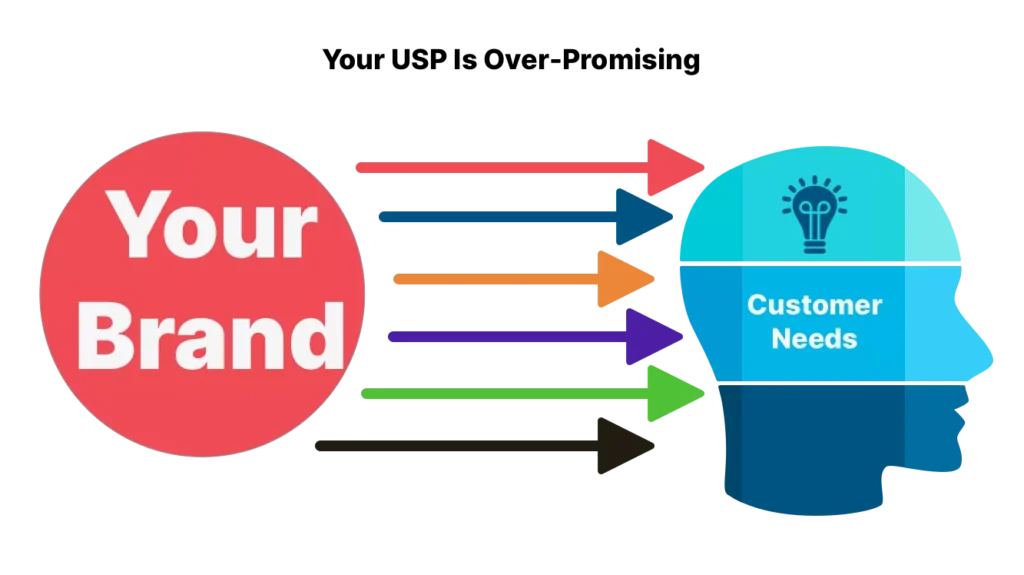What is a Unique Selling Proposition?
Imagine you’re buying a house, a car, or something else specific that you really need.
You’ve narrowed it down to a few potential options, and now you’re trying to decide which one to choose.
Here’s the thing: to make the final decision, you need to find something that perfectly fits your expectations:
A clear and unique message or idea that sets this option apart from all the others and makes you think it’s the perfect fit for you! That’s what it is.

We marketers call it a USP or unique selling proposition which is a result of your brand’s Differentiation and Positioning.
But let’s just get straight to the business.
Now you’re selling your products or services. Your clients too need a reason to choose you over one of your competitors. Which exact and specific message will you use? What is different about your solution that solves their needs better than the other alternatives?
If you’re an entrepreneur asking yourself “Why don’t I have enough clients?” – probably, here is the answer to your question.
Without a unique selling proposition, your business/product/service will be “just another place to forget about”.
Let’s see how we can get you a brilliant USP to get your buyers to you.
Why You Need This USP
First, adopt this idea: You are not that important to them!
People don’t think about your product much. They don’t care about your brand and your service and your company and yourself. People think about themselves and their ultimate goals.
Your clients consider your product and your service just as a tool to reach their goals, solve their problems and themselves be the superheroes.
Second, this may sound surprising: Often, people don’t know what they want.
And they can’t express these thoughts clearly to themselves.
Your clients are not always explicit and honest with themselves.
Remember yourself: Often you know (or feel) you need to buy this really cool thing,
but you don’t explicitly articulate to yourself why.
So, the way people make their buying decisions is always a lot of magic that the best marketing minds are still trying to solve (and not always succeed).
Powerful USP reaching their hearts and minds will help them understand you’re important to them. Marketing researches show that effective USPs boost conversion rates (from visitor -> to customer) by a considerable margin.
It makes sense to start welcoming your visitors with your USP at the Interest Stage of the funnel (read more about the funnel here) when they stop by your website and say: “OK. Show me more!”
Also, note that a business can have more than one USP. You can use them together or separately depending on what you want to tell to each customer.
Typical Mistakes to Avoid
We’ll emphasize this again, people do not think about your brand every minute (unless they are your mom)! Consumers think about themselves and want to solve their problems with a product/service. They will never buy anything that offers zero benefits for them.
There are three main ways how you can fail to deliver your USP to the target audience
USP Is Too Vague

You are not clear. People just don’t understand what you’re trying to say.
Your website or advertising banner is a mess.
USP Is Over-Promising

You’re talking too much.
You say you’re the best at everything, but people don’t believe you or get overloaded with information.
USP For Wrong Audience

You’re delivering your message to the wrong people.
For example, you’re trying to sell a luxury watch to a guy who just lost his job.
Unique Selling Proposition Examples
Here are some examples that you can use to draw inspiration for identifying your own USPs.
- Death Wish Coffee: Their USP is the strongest coffee in the world, appealing to those who need a serious caffeine kick. “The World’s Strongest Coffee.”
- Maille Mustard: Their USP is their centuries-old heritage and unique mustard flavors, positioning them as the gourmet choice. “Since 1747, the choice of chefs & connoisseurs.”
- Bombas: Their USP is their “One Purchased = One Donated” model for socks, appealing to socially conscious consumers who want to give back. “Bee Better.”
- Buckley’s: Their cough medicine may taste like $#(^, but it works. That’s their USP. “It tastes awful. And it works.”
- Disneyland: They’ve got rides, shows, and characters for people of all ages. This is why they say, it is “the happiest place on Earth.”
- Dollar Shave Club: Their razor blades are high quality and last longer than the competition. That means you save time and money in the long run. “Shave time. Shave money.”
- Rothy’s: They’re a sustainable fashion company that makes stylish shoes from eco-friendly materials. “Reduce your carbon footprint in style.”
- Staples: They have everything you need for school or the office, and they make it easy to find what you’re looking for. “That was easy.”
Awesome USPs can be based on your business strategy: Price, Time, Quality, or Variety – check this article as well. These are the best things about your business that make customers want to buy from you.
Takeaways
- Your customers aren’t buying your product; they’re buying the solution to their problems.
- A strong USP isn’t just a marketing buzzword. It sets you apart, attracts the right customers, and fuels your growth.
- Don’t be just another brand; be the only brand that truly understands and satisfies your customers.
- Don’t be too shy, but also don’t shout too much. Pick the right audience.







